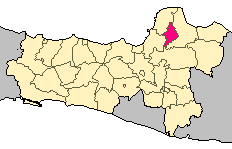Kudus Regency
- This article refers to the regency in Indonesia; see also Al-Quds (Jerusalem)
Kudus Regency
Kabupaten Kudus | |
|---|---|
Regency (Kabupaten) | |
 Coat of arms | |
 Kudus Regency in Central Java | |
| Coordinates: 6°48′S 110°50′E / 6.800°S 110.833°ECoordinates: 6°48′S 110°50′E / 6.800°S 110.833°E | |
| Country | Indonesia |
| Province | Central Java |
| Districts | show
List |
| Government | |
| • Acting Regent | Hartopo |
| Area | |
| • Total | 425.16 km2 (164.16 sq mi) |
| Population (mid 2019)[1] | |
| • Total | 871,311 |
| • Density | 2,000/km2 (5,300/sq mi) |
| Time zone | UTC+7 (WIB) |
| Post Code | 593xx |
| Area code(s) | 0291 |
| Website | kuduskab.go.id |
Kudus (Javanese: ꦏꦸꦢꦸꦱ꧀) is a regency (Indonesian: kabupaten) in Central Java province in Indonesia. Its capital is Kudus. It covers 425.16 km2 and is thus the smallest regency on Java Island in area, and it had a population of 777,437 at the 2010 Census;[2] the latest official estimate (as at mid 2019) is 871,311.[3] It is located east of Semarang, capital of Central Java.
History[]

The city of Kudus was something of an important Islamic holy city in the sixteenth century. It is the only place in Java that has permanently acquired an Arabic name ('al-Quds', Jerusalem). Sunan Kudus, one of the nine Wali Sanga, was said to have been the fifth imam (head) of the mosque of Demak and a major leader of the 1527 campaign against 'Majapahit', before moving to Kudus.
The Mosque of Kudus (Masjid Menara) which dates from this period, remains a local landmark to this day. It is notable for both its perseverance of pre-Islamic architectural forms such as Old Javanese split doorways and Hindu-Buddhist influenced Majapahit-style brickwork,[4] and for its name al-Manar or al-Aqsa. The date AH 956 (AD 1549) is inscribed over the mihrab (niche indicating the direction of Mecca).[5]
Administrative districts[]
The Regency comprises nine districts (kecamatan), tabulated below with their areas and their populations at the 2010 Census,[6] together with the latest official estimates (for mid 2019).[7] The table also includes the number of administrative villages (rural desa and urban kelurahan) in each district and its post code.
| Name | Area in km2 |
Pop'n Census 2010 |
Pop'n Estimate mid 2019 |
No. of vill. |
Post code |
|---|---|---|---|---|---|
| Kaliwungu | 32.71 | 91,174 | 105,310 | 15 | 59332 |
| Kota Kudus (Kudus town) | 10.47 | 92,776 | 94,147 | 25 | 59311 -59319 |
| Jati | 26.30 | 99,466 | 110,621 | 14 | 59341 -59349 |
| Undaan | 71.77 | 69,073 | 79,403 | 15 | 59372 |
| Mejobo | 36.77 | 69,754 | 79,507 | 11 | 59381 |
| Jekulo | 82.92 | 98,741 | 111,461 | 12 | 59382 |
| Bae | 23.32 | 66,333 | 74,463 | 10 | 59321 -59327 |
| Gebog | 55.06 | 93,915 | 106,768 | 11 | 59333 |
| Dawe | 85.84 | 96,205 | 109,631 | 18 | 59353 |
| Totals | 425.16 | 777,437 | 871,311 | 132 |
Contemporary Kudus[]
Although most residents of Kudus are Javanese, there is an Indonesian Chinese minority in the city center, as well as an Arab neighborhood, Kudus Kulon, to the west of the city center.
The city is considered the "birthplace" of the kretek clove cigarette, which is by far the most widely smoked form of tobacco in the country, and remains a major center for their manufacture. Haji Jamahri, a resident of the city, invented them in the 1880s. A festival named is held for about one whole month before Ramadhan, Muslim's fasting month in Kudus Kulon.
Anti-nuclear movement[]
On 12 June 2007, about 5,000 people gathered peacefully to protest against Jakarta's plan to build 4 nuclear reactors in the region. The movement included local residents, activists, artists, students and public officials, parliament members, military commandants and police chiefs. This movement has been part of a series of responses emerging from all sides of the Indonesian society against the use of nuclear technology for energy production.
Notable people[]
- Hariyanto Arbi, badminton player
- Hermawan Susanto, badminton player
- Liem Swie King, badminton player
- Eddy Hartono, badminton player
See also[]
References[]
- ^ Badan Pusat Statistik, Jakarta, 2020.
- ^ Biro Pusat Statistik, Jakarta, 2011.
- ^ Badan Pusat Statistik, Jakarta, 2020.
- ^ Schoppert, P., Damais, S., Java Style, 1997, Didier Millet, Paris, 207 pages, ISBN 962-593-232-1
- ^ Ricklefs, M.C. (1991). A History of Modern Indonesia since c.1300, 2nd Edition. London: MacMillan. p. 38. ISBN 0-333-57689-6.
- ^ Biro Pusat Statistik, Jakarta, 2011.
- ^ Badan Pusat Statistik, Jakarta, 2020.
External links[]
| Wikivoyage has a travel guide for Kudus. |
- Minaret at Kudus - ArchNet.org
- Regencies of Central Java
- Central Java geography stubs

